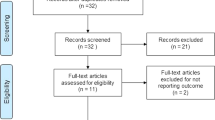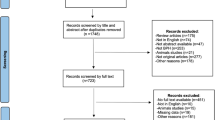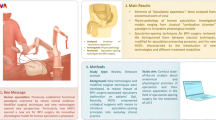Abstract
Background
The surgical landscape for Lower Urinary Tract Symptoms (LUTS) and Benign Prostatic Hyperplasia (BPH) has evolved with the introduction of Minimally Invasive Surgical Therapies (MISTs), recognizing the impact of sexual function on patients’ well-being, and prioritizing ejaculation-sparing approaches.
Methods
This systematic review explored ejaculation sparing after classic endoscopic procedures and MISTs (iTind, Rezūm, Urolift, Aquablation, and TPLA) and a literature search yielded 41 studies.
Results
While all procedures demonstrated efficacy in improving LUTS/BPH symptoms (IPSS, QoL, Qmax), a subset of studies evaluated ejaculatory function. Positive outcomes were noted, challenging the historical association of BPH surgeries with ejaculatory dysfunction. Variations in study design, patient cohorts, and limited long-term data present challenges. Notably, the lack of baseline specificity, use of alpha-blockers, and non-specific sexual function assessments underscore potential biases.
Conclusions
Despite limitations, the review tentatively concluded that MISTs, including iTind, Rezūm, Urolift, Aquablation, and TPLA, appear comparable in sparing ejaculation. Long-term studies are essential to validate sustainability, and comparative research should assess trade-offs between MISTs and traditional surgeries. Incorporating patient-reported outcomes and quality of life assessments will enhance future investigations, refining MISTs as standard therapeutic options for LUTS/BPH.
This is a preview of subscription content, access via your institution
Access options
Subscribe to this journal
Receive 4 print issues and online access
$259.00 per year
only $64.75 per issue
Buy this article
- Purchase on Springer Link
- Instant access to full article PDF
Prices may be subject to local taxes which are calculated during checkout

Similar content being viewed by others
References
Oelke M, Bachmann A, Descazeaud A, Emberton M, Gravas S, Michel MC, et al. EAU guidelines on the treatment and follow-up of non-neurogenic male lower urinary tract symptoms including benign prostatic obstruction. Eur Urol. 2013;64:118–40.
Busetto GM, Checchia A, Recchia M, Tocci E, Falagario UG, Annunziata G, et al. Minimally invasive surgical therapies (MISTs) for lower urinary tract symptoms (LUTS): promise or panacea? Asian J Androl. https://doi.org/10.4103/aja202357 (2023).
Malde S, Umbach R, Wheeler JR, Lytvyn L, Cornu JN, Gacci M, et al. A systematic review of patients’ values, preferences, and expectations for the diagnosis and treatment of male lower urinary tract symptoms. Eur Urol. 2021;79:796–809.
Del Giudice F, Oh JK, Basran S, Nicaise E, Hyun Song P, Kim W, et al. Recent trends in the diagnostic and surgical management of benign prostatic hyperplasia in the U.S. from 2004 to 2017: Annual changes in the selection of treatment options and medical costs. Appl Sci. 2022;12:8697.
McVary KT, Gange SN, Gittelman MC, Goldberg KA, Patel K, Shore ND, et al. Erectile and ejaculatory function preserved with convective water vapor energy treatment of lower urinary tract symptoms secondary to benign prostatic hyperplasia: randomized controlled study. J Sex Med. 2016;13:924–33.
Ray AF, Powell J, Speakman MJ, Longford NT, DasGupta R, Bryant T, et al. Efficacy and safety of prostate artery embolization for benign prostatic hyperplasia: an observational study and propensity-matched comparison with transurethral resection of the prostate (the UK-ROPE study). BJUI. 2018;122:270–82.
Amparore D, Fiori C, Valerio M, Schulman C, Giannakis I, De Cillis S, et al. 3-Year results following treatment with the second generation of the temporary implantable nitinol device in men with LUTS secondary to benign prostatic obstruction. Prostate Cancer Prostatic Dis. 2021;24:349–57.
De Nunzio C, Cantiello F, Fiori C, Crocerossa F, Tognoni P, Amparore D, et al. Urinary and sexual function after treatment with temporary implantable nitinol device (iTind) in men with LUTS: 6-month interim results of the MT-06-study. World J Urol. 2021;39:2037–42.
Elterman D, Alshak MN, Martinez Diaz S, Shore N, Gittleman M, Motola J, et al. An evaluation of sexual function in the treatment of lower urinary tract symptoms secondary to benign prostatic hyperplasia in men treated with the temporarily implanted nitinol device. J Endourol. 2023;37:74–79.
Kadner G, Valerio M, Giannakis I, Manit A, Lumen N, Ho BSH, et al. Second generation of temporary implantable nitinol device (iTind) in men with LUTS: 2 year results of the MT-02-study. World J Urol. 2020;38:3235–44.
Porpiglia F, Fiori C, Amparore D, Kadner G, Manit A, Valerio M, et al. Second-generation of temporary implantable nitinol device for the relief of lower urinary tract symptoms due to benign prostatic hyperplasia: results of a prospective, multicentre study at 1 year of follow-up. BJU Int. 2019;123:1061–9.
Porpiglia F, Fiori C, Bertolo R, Garrou D, Cattaneo G, Amparore D. Temporary implantable nitinol device (TIND): a novel, minimally invasive treatment for relief of lower urinary tract symptoms (LUTS) related to benign prostatic hyperplasia (BPH): feasibility, safety and functional results at 1 year of follow-up. BJU Int. 2015;116:278–87.
Alegorides C, Fourmarier M, Eghazarian C, Lebdai S, Chevrot A, Droupy S. Treatment of benign prostate hyperplasia using the Rezum® water vapor therapy system: Results at one year. Prog Urol. 2020;30:624–31.
Dixon CM, Cedano ER, Pacik D, Vit V, Varga G, Wagrell L, et al. Two-year results after convective radiofrequency water vapor thermal therapy of symptomatic benign prostatic hyperplasia. Res Rep. Urol. 2016;21:207–16.
Gupta N, Rogers T, Holland B, Helo S, Dynda D, McVary KT. Three-year treatment outcomes of water vapor thermal therapy compared to Doxazosin, Finasteride and combination drug therapy in men with benign prostatic hyperplasia: cohort data from the MTOPS Trial. J Urol. 2018;200:405–13.
Johnston MJ, Noureldin M, Abdelmotagly Y, Paramore L, Gehring T, Nedas TG, et al. Rezum water vapour therapy: promising early outcomes from the first UK series. BJU Int. 2020;126:557–8.
Mollengarden D, Goldberg K, Wong D, Roehrborn C. Convective radiofrequency water vapor thermal therapy for benign prostatic hyperplasia: a single office experience. Prostate Cancer Prostatic Dis. 2018;21:379–85.
Roehrborn CG, Gange SN, Gittelman MC, Goldberg KA, Patel K, Shore ND, et al. Convective thermal therapy: durable 2-year results of randomized controlled and prospective crossover studies for treatment of lower urinary tract symptoms due to benign prostatic hyperplasia. J Urol. 2017;197:1507–16.
Siena G, Cindolo L, Ferrari G, Maruzzi D, Fasolis G, Condorelli SV, et al. Water vapor therapy (Rezūm) for lower urinary tract symptoms related to benign prostatic hyperplasia: early results from the first Italian multicentric study. World J Urol. 2021;39:3875–80.
McVary KT, Rogers T, Roehrborn CG. Rezūm water vapor thermal therapy for lower urinary tract symptoms associated with benign prostatic hyperplasia: 4-year results from randomized controlled study. Urology. 2019;126:171–9.
Tutrone RF, Schiff W. Early patient experience following treatment with the UroLift prostatic urethral lift and Rezum steam injection. Can J Urol. 2020;27:10213–9.
Annese P, d’Altilia N, Mancini V, Falagario UG, Del Giudice F, Ferro M, et al. Preserving ejaculatory function in young patients with lower urinary tract symptoms: medium- to long-term follow-up of prostatic urethral lift at a single center. Ther Adv Urol. 2021;13:17562872211037109.
Bardoli AD, Taylor WSJ, Mahmalji W. Can the UroLift prostatic implant device treat the symptoms of benign prostatic hypertrophy, avoid sexual dysfunction and reduce hospital TURP waiting times? A single centre, single surgeon experience and review of the literature. Aging Male. 2017;20:192–7.
Eure G, Gange S, Walter P, Khan A, Chabert C, Mueller T, et al. Real-world evidence of prostatic urethral lift confirms pivotal clinical study results: 2-year outcomes of a retrospective multicenter study. J Endourol. 2019;33:576–84.
Kim JH, Lee KS, Kim TH. Evaluation of clinical outcomes of prostatic urethral lift for benign prostatic hyperplasia: An Asian population study. World J Mens Health. 2020;38:338–44.
Roehrborn CG, Rukstalis DB, Barkin J, Gange SN, Shore ND, Giddens JL, et al. Three year results of the prostatic urethral L.I.F.T. study. Can J Urol. 2015;22:7772–82.
Woo HH, Bolton DM, Laborde E, Jack G, Chin PT, Rashid P, et al. Preservation of sexual function with the prostatic urethral lift: a novel treatment for lower urinary tract symptoms secondary to benign prostatic hyperplasia. J Sex Med. 2012;9:568–75.
Gratzke C, Barber N, Speakman MJ, Berges R, Wetterauer U, Greene D, et al. Prostatic urethral lift vs. transurethral resection of the prostate: 2-year results of the BPH6 prospective, multicentre, randomized study. BJU Int. 2017;119:767–75.
McVary KT, Gange SN, Shore ND, Bolton DM, Cowan BE, Brown BT, et al. Treatment of LUTS secondary to BPH while preserving sexual function: randomized controlled study of prostatic urethral lift. J Sex Med. 2014;11:279–87.
Sønksen J, Barber NJ, Speakman MJ, Berges R, Wetterauer U, Greene D, et al. Prospective, randomized, multinational study of prostatic urethral lift versus transurethral resection of the prostate: 12-month results from the BPH6 study. Eur Urol. 2015;68:643–52.
de Rienzo G, Lorusso A, Minafra P, Zingarelli M, Papapicco G, Lucarelli G, et al. Transperineal interstitial laser ablation of the prostate, a novel option for minimally invasive treatment of benign prostatic obstruction. Eur Urol. 2021;80:95–103.
Pacella CM, Patelli G, Iapicca G, Manenti G, Perretta T, Ryan CP, et al. Transperineal laser ablation for percutaneous treatment of benign prostatic hyperplasia: a feasibility study. Results at 6 and 12 months from a retrospective multi-centric study. Prostate Cancer Prostatic Dis. 2020;23:356–63.
Gilling PJ, Barber N, Bidair M, Anderson P, Sutton M, Aho T, et al. Randomized controlled trial of aquablation versus transurethral resection of the prostate in benign prostatic hyperplasia: one-year outcomes. Urology. 2019;125:169–73.
Misrai V, Rijo E, Zorn KC, Barry-Delongchamps N, Descazeaud A. Waterjet ablation therapy for treating benign prostatic obstruction in patients with small- to medium-size glands: 12-month results of the first French Aquablation Clinical Registry. Eur Urol. 2019;76:667–75.
Bhojani N, Bidair M, Kramolowsky E, Desai M, Doumanian L, Zorn KC, et al. Aquablation therapy in large prostates (80-150 mL) for lower urinary tract symptoms due to benign prostatic hyperplasia: Final WATER II 5-year clinical trial results. J Urol. 2023;210:143–53.
Desai M, Bidair M, Zorn KC, Trainer A, Arther A, Kramolowsky E, et al. Aquablation for benign prostatic hyperplasia in large prostates (80–150 mL): 6-month results from the WATER II trial. BJU Int. 2019;124:321–32.
Raizenne BL, Bouhadana D, Zorn KC, Barber N, Gilling P, Kaplan S, et al. Functional and surgical outcomes of Aquablation in elderly men. World J Urol. 2022;40:2515–2020.
Gilling P, Barber N, Bidair M, Anderson P, Sutton M, Aho T, et al. Three-year outcomes after Aquablation therapy compared to TURP: results from a blinded randomized trial. Can J Urol. 2020;27:10072–9.
Gilling PJ, Barber N, Bidair M, Anderson P, Sutton M, Aho T, et al. Five-year outcomes for Aquablation therapy compared to TURP: results from a double-blind, randomized trial in men with LUTS due to BPH. Can J Urol. 2022;29:10960–8.
Alloussi SH, Lang C, Eichel R, Alloussi S. Ejaculation-preserving transurethral resection of prostate and bladder neck: short- and long-term results of a new innovative resection technique. J Endourol. 2014;28:84–89.
Gul Z, Chughtai B, Te AE, Thomas D, Kaplan SA. Ejaculatory preserving middle lobe onl-transurethral resection and vaporization of the prostate: 12-year experience. Urology. 2019;134:199–202.
Kini M, Te AE, Kashanian JA, Kaplan S, Chughtai B. Ejaculatory hood-sparing photoselective vaporization of the prostate vs. bipolar button plasma vaporization of the prostate in the surgical management of benign prostatic hyperplasia. J Endourol. 2020;34:322–9.
Elshazly M, Sultan S, Shaban M, Zanaty F. Evaluation of a novel technique of bladder neck and supramontanal sparing ejaculatory preserving transurethral prostatectomy. World J Urol. 2021;39:4215–9.
Manasa T, Reddy N, Puvvada S, Mylarappa P. Evaluating outcomes of combined bladder neck and supramontanal sparing ejaculatory preserving transurethral resection of the prostate: Results from a prospective, randomised study. Cent Eur J Urol. 2022;75:292–8.
Migliari R, Mele F, Barale M, De Rosa G, Migliari M, Giacobbe A. An innovative technique for ejaculation-sparing prostatic enucleation with Thulium:YAG Laser. J Endourol. 2023;37:1282–8.
Leonardi R. Preliminary results on selective light vaporization with the side-firing 980 nm diode laser in benign prostatic hyperplasia: an ejaculation sparing technique. Prostate Cancer Prostatic Dis. 2009;12:277–80.
MacRae C, Gilling P. How I do it: Aquablation of the prostate using the AQUABEAM system. Can J Urol. 2016;23:8590–3.
Sibona M, Destefanis P, Vercelli E, Secco S, Gontero P, Cindolo L. Ejaculation physiology and dysfunction after BPH surgery: the role of the new MISTs. Prostate Cancer Prostatic Dis. 2023;26:475–82.
Porreca A, Colicchia M, Tafuri A, D’Agostino D, Busetto GM, Crestani A, et al. Perioperative outcomes of Holmium laser enucleation of the prostate: a systematic review. Urol Int. 2022;106:979–91.
Grosso AA, Amparore D, Di Maida F, de Cillis S, Cocci A, Di Dio M, et al. Comparison of perioperative and short-terms outcomes of en-bloc Holmium laser enucleation of the prostate (HoLEP) and robot-assisted simple prostatectomy: a propensity-score matching analysis. Prostate Cancer Prostatic Dis. https://doi.org/10.1038/s41391-023-00743-6 (2023)
Porreca A, Schiavina R, Romagnoli D, Corsi P, Salvaggio A, D’Agostino D, et al. T-L technique for HoLEP: perioperative outcomes of a large single-centre series. Cent Eur J Urol. 2021;74:366–71.
Cash H, Wendler JJ, Minore A, Goumas IK, Cindolo L. Primary bladder neck obstruction in men—new perspectives in physiopathology. Prostate Cancer Prostatic Dis. 2024;27:54–57.
Cocci A, Pezzoli M, Lo Re M, Russo GI, Asmundo MG, Fode M, et al. Quality of information and appropriateness of ChatGPT outputs for urology patients. Prostate Cancer Prostatic Dis. 2024;27:159–60.
Destefanis P, Sibona M, Vitiello F, Vercelli E, Micai L, Montefusco G, et al. Trans - Perineal laser ablation of the prostate in high surgical risk patients affected by severe lower urinary tract symptoms related to benign prostatic obstruction. Prostate Cancer Prostatic Dis. https://doi.org/10.1038/s41391-023-00736-5 (2023)
Nguyen DD, Li T, Ferreira R, Baker Berjaoui M, Nguyen ALV, Chughtai B, et al. Ablative minimally invasive surgical therapies for benign prostatic hyperplasia: A review of Aquablation, Rezum, and transperineal laser prostate ablation. Prostate Cancer Prostatic Dis. 2024;27:22–28.
Sahakyan Y, Erman A, Bhojani N, Chughtai B, Zorn KC, Sander B, et al. Pharmacotherapy vs. minimally invasive therapies as initial therapy for moderate-to-severe benign prostatic hyperplasia: a cost-effectiveness study. Prostate Cancer Prostatic Dis. 2023;26:113–8.
Speakman MJ, Cornu J, Gacci M, Gratzke C, Mamoulakis C, Herrmann RW, et al. What Is the required certainty of evidence for the implementation of novel techniques for the treatment of benign prostatic obstruction? Eur Urol Focus. 2019;5:351–6.
Author information
Authors and Affiliations
Contributions
Conceptualization GMB and RL; Data curation GS, ET and NS; Formal analysis GMB and RL; Methodology AT, CDN and GC; Project administration AT, CDN and GC; Resources TRH and SAK; Supervision GMB, RL, TRH and SAK; Writing-original draft GS, ET and NS; Writing-review & editing GMB, RL and TRH. All authors have read and agreed to the published version of the manuscript.
Corresponding author
Ethics declarations
Competing interests
The authors declare no competing interests.
Additional information
Publisher’s note Springer Nature remains neutral with regard to jurisdictional claims in published maps and institutional affiliations.
Rights and permissions
Springer Nature or its licensor (e.g. a society or other partner) holds exclusive rights to this article under a publishing agreement with the author(s) or other rightsholder(s); author self-archiving of the accepted manuscript version of this article is solely governed by the terms of such publishing agreement and applicable law.
About this article
Cite this article
Busetto, G.M., Lombardo, R., De Nunzio, C. et al. Ejaculation sparing of classic and minimally invasive surgical treatments of LUTS/BPH. Prostate Cancer Prostatic Dis (2024). https://doi.org/10.1038/s41391-024-00834-y
Received:
Revised:
Accepted:
Published:
DOI: https://doi.org/10.1038/s41391-024-00834-y



